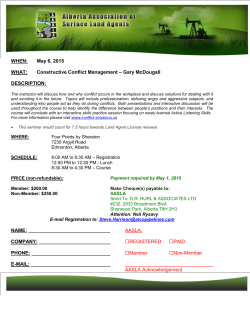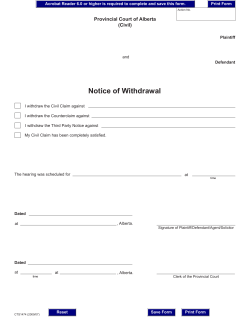
View as PDF - WordPress.com
Curriculum Vitae – D. Raab Page 1 DUSTIN RAAB, M.SC. PhD Candidate, NSERC Canada Graduate Scholar OFFICE Redpath Museum, Biology Department McGill University 859 Sherbrooke St. West Montreal QC, H3A 0C4 dustin.raab@mail.mcgill.ca PERSONAL Born Peterborough, Ontario, Canada. Canadian Citizen. EDUCATION Ph.D. Candidate and NSERC Canada Graduate Scholar, McGill University, Redpath Museum, Department of Biology, 2013 - current. M.Sc., University of Alberta, Ecology, Department of Biological Sciences, Conferred 2010. B.Sc. (with distinction), McGill University, Biology, Conferred 2005. AWARDS AND FUNDING NSERC Alexander Graham Bell Canada Graduate Scholarship (Government of Canada), 2014-2017 Delise Alison Student Development Award (Redpath Museum, McGill University), 2015 Best Student Poster (Canadian Aqautic Invasive Species Network annual meeting), 2014 Graduate Excellence Award in Biology (McGill University), 2013 NSERC Industrial Postgraduate Scholarship (Government of Canada), 2007-2009 Alberta Advanced Education Graduate Scholarship (Government of Alberta), 2008 Circumpolar/Boreal Alberta Research Grant (Canadian Circumpolar Institute), 2007, 2008 Northern Scientific Training Program Research Grant (Government of Canada), 2007, 2008 Queen Elizabeth II Graduate Scholarship Award (University of Alberta), 2007 Alberta Conservation Association Grant in Biodiversity, 2007 PUBLICATIONS Curriculum Vitae – D. Raab Page 2 PEER REVIEWED 4. Raab, D., Rooney, R.C., and Bayley, Suzanne E. 2014. A visual obstruction method to estimate wet meadow aboveground biomass in marshes of the Boreal Plains, Canada. Wetlands. 34:363-367 3. Raab, Dustin, and Bayley Suzanne E. 2013. A Carex species-dominated marsh community represents the best short-term target for reclaiming oil sands affected wetlands in Alberta, Canada. Ecological Engineering 54:97-106 2. Raab, Dustin, and Bayley Suzanne E. 2012. A vegetation-based Index of Biotic Integrity to assess marsh reclamation success in the Alberta oil sands, Canada. Ecological Indicators 15:43-51 1. Rooney, Rebecca C., Bayley, Suzanne E., and Raab, Dustin. 2011. Plant community, environment, and land-use data from oil sands reclamation and reference wetlands, Alberta, 2007-2009. Ecology 92:2003 TECHNICAL REPORTS 4. Ciborowski, Jan J.H., Kang, Misun, Raab, Dustin, Bayley, Suzanne E., and Foote, A. Lee. 2011. Synthesis: Applying the reference condition approach for monitoring reclamation areas in the Athabasca oil sands region. Technical report submitted to the Cumulative Environmental Management Association, Edmonton, Alberta. 3. Raab, Dustin, and Bayley Suzanne E. 2009. Wet meadow vegetation studies: marsh fertilization to enhance sedge meadow growth and the Robel pole rapid standing crop assessment method. Technology transfer fact sheet for the Cumulative Environmental Management Association. 2. Raab, Dustin, and Bayley Suzanne E. 2009. Assessing wetland construction in Alberta's oil sands: marsh vegetation as a reclamation target. Alberta Conservation Association Grants in Biodiversity Biennial Report 2008/2009. 1. Raab, Dustin, Roche, Dominique, and Guzmàn, Hector M. (2005) Preliminary assessment of the artisanal fishery in the town of Pedro Gonzalez, Archipelago of Las Perlas, Panama. Undergraduate internship research report submitted to the Smithsonian Tropical Research Institute, Panama. PRESENTATIONS CONTRIBUTED TALKS 7. Raab, Dustin, Mandrak, Nicholas E., and Ricciardi, Anthony. 2015. Round Goby impact on native fishes in a flow-modified tributary. Paper presentation at the Association for the Study of Limnology and Oceanography annual meeting, Granada, Spain. 6. Raab, Dustin, Mandrak, Nicholas E., and Ricciardi, Anthony. 2014. Going against the flow? Round Goby abundance varies along physical gradients in a dammed Great Lakes tributary. Poster presentation at the American Fisheries Society annual meeting, Quebec City, Quebec, Canada. 5. Raab, Dustin, Mandrak, Nicholas E. , and Ricciardi, Anthony. 2014. Round Goby invasion of a dammed Great Lakes tributary: factors affecting abundance. Poster presentation at the Canadian Aquatic Invasive Species Network annual meeting, Curriculum Vitae – D. Raab Page 3 Gatineau, Quebec, Canada. 4. Raab, Dustin, Mandrak, Nicholas E., and Ricciardi, Anthony. 2014. Competition among invasive Round Goby and a native benthic fishes across an environmental gradient. Speed talk presentation at the McGill Conservation Ecology and Evolutionary Biology annual retreat, Mont St. Hilaire, Quebec, Canada. 3. Raab, Dustin, Mandrak, Nicholas E., and Ricciardi, Anthony. 2013. Les impacts du gobie à taches noires dans les affluents des barrages des Grands Lacs. Speed talk presentation at the Quebec Centre for Biodiversity Science annual meeting, Montreal, Quebec, Canada. 2. Raab, Dustin. 2010. Reclamation of wetland habitat in the Alberta oil sands: Generating assessment targets using boreal marsh vegetation communities. M.Sc. thesis defense public lecture. University of Alberta, Edmonton, Alberta, Canada. 1. Raab, Dustin. 2009. Assessing the success of wetland construction in Alberta's oil sands: Marsh vegetation as a reclamation target. Paper presentation at the Society of Wetland Scientists annual meeting, Madison, Wisconsin, USA. INVITED TALKS 3. Raab, Dustin, Rebecca C. Rooney and Suzanne E. Bayley. 2010. Assessment of Indices of Biotic Integrity and Performance Indicators of wetland health for oil sands and natural reference wetlands. Presentation to the Cumulative Environmental Management Association Reclamation Working Group, Edmonton, Alberta, Canada. 2. Raab, Dustin, and Rebecca C. Rooney. 2008. How to assess reclamation success in the Athabasca Oil Sands? Plants as indicators. Invited lecture to Graduate Seminar in Plant Ecology at the University of Alberta, Edmonton, Alberta, Canada. 1. Raab, Dustin, and Rebecca C. Rooney. 2008. Indices of Biotic Integrity and Performance Indicators of Wetland Health for Oil Sands and Natural Reference Wetlands. CONRAD Environmental Reclamation and Research Group annual symposium, Alberta Research Council, Edmonton, Alberta, Canada. EMPLOYMENT Aquatic Science Technician, Fisheries and Oceans Canada, Burlington, Ontario, Canada. May 2013 - September 2013 Habitat Biologist, Fisheries and Oceans Canada, Kamloops, British Columbia, Canada. June 2011 - March 2012 Habitat Biologist, Fisheries and Oceans Canada, Edmonton, Alberta, Canada. December 2010 - June 2011 Consultant in Environmental Monitoring, Edmonton, Alberta, Canada. 2010 Wetland Biologist, University of Alberta, Department of Biological Sciences. 2010 Student Researcher, Smithsonian Tropical Research Institute, Panama City, Panama. 2005 Research Assistant, McGill University, Neil Price Lab, Canadian Arctic Shelf Ecosystem Study. Summer 2004 Curriculum Vitae – D. Raab Page 4 Research Assistant, McGill University, Daniel Schoen Lab. Summer 2003 Field Assistant, McGill University, Joseph Rasmussen Lab. Summer 2003 TEACHING TEACHING ASSISTANTSHIPS Methods in Biology of Organisms (BIOL 206), McGill University, 2014 Mechanisms of Animal Behaviour (ZOOL 370), University of Alberta, 2007 Introduction to Biological Diversity (BIOL 108), University of Alberta, 2006 GUEST LECTURES Wetland Ecology and Management (BIOL 333), University of Alberta, 2007, 2008 SERVICE AND OUTREACH Treasurer, McGill Biology Graduate Student Association, 2014-present Volunteer bicycle mechanic, The Flat Bicycle Cooperative, Montreal, Quebec, 2014present Volunteer naturalist, High Park Nature Centre, Toronto, Ontario, 2012 PROFESSIONAL MEMBERSHIPS Association for the Study of Limnology and Oceanography (ASLO) American Fisheries Society (AFS) FORMAL TRAINING AND CERTIFICATION Electrofishing Class I certification with the Watershed Institute and Ontario Ministry of Natural Resources, 2014 Fish identification training (regular and species-at-risk) with the Royal Ontario Museum, 2013 Managing the Hostile Individual course with the Justice Institute of BC, 2012 Marine Emergency Duties (MEDA3) certification with the Canadian Coast Guard, 2011 Small Vessel Operator (SVOP) certification with the Canadian Coast Guard, 2011 Swiftwater Rescue Technician (SRT1) certification with Raven Rescue, 2011 Canadian Environmental Assessment Agency introductory course for biologists, 2011 Underwater aircraft egress training with Pro Aviation, 2011 Wilderness survival training with the Boreal Wilderness Institute, 2011 Standard first aid and CPR certification, 2010 Firearms possession and acquisition license Advanced Open Water diver certification Curriculum Vitae – D. Raab Page 5 SKILLS Planning and experimental design – Experience developing and implementing field monitoring and inventorying programs for ecological surveillance and assessment of impacted and natural ecosystems; logistical organization and supervision of field sampling team. Species identification –formally trained in the identification of native and introduced inland and anadromous aquatic species. Familiar with terrestrial and avian species of northern and central Canada, including species at risk. Skilled in the identification of aquatic, riparian, rare and invasive plant species of the Boreal forest and northern Canada. Habitat and ecological assessment – Trained in the use of habitat assessment techniques such as snorkel surveys, aerial counts from helicopter, rapid aquatic habitat assessment, the Index of Biological Integrity, radio telemetry and GPS tagging and monitoring techniques, instream flow measurements.. Fish and aquatic assessment – Backpack and boat electrofishing, benthic and pelagic trawling, gill netting, fyke netting, beach seining, pole seining, snorkel surveys, markrecapture, stomach content sampling, aerial (helicopter) spawning and redd counts. Macroinvertebrate assessment – Kick netting, D-netting, and quantitative Surber sampling for abundance estimates and species composition. Vegetation assessment – Extensive experience with field sampling techniques for vegetation diversity and abundance. Laboratory techniques – Water, sediment, vegetation, macroinvertebrate and fish sample preparation and analysis with a wide variety of equipment and techniques. Experience preparing samples for nutrient, isotopic, and genetic analysis, and conducting dissections for stomach contents. Statistical techniques – Univariate and multivariate statistical procedures in R, SPSS, and SigmaPlot software; familiarity with current methods of analysis of ecological communities including indicator species analysis to identify keystone species. Computer applications – Skilled with word processing software, preparing presentations to management, peers, and stakeholders using Microsoft PowerPoint; management of databases of ecological information in Microsoft Excel and Access. Communication and consultation – Preparation of peer-reviewed scientific manuscripts; report reviewing and writing; oral presentations to peers, funding partners (including First Nations, government, and industrial stakeholders), and environmental agencies; excellent tact, judgment, and interpersonal skills. Policy work – Participation on multi-disciplinary teams with government and industry agencies during the development of the new Alberta wetland policy; coordination between Provincial and Federal fisheries and habitat policy towards the implementation of DFO’s mandate; collaboration with a multidisciplinary habitat stewardship group in the BC Interior. Fieldwork and outdoors – Sampling in remote locations for extended periods; operation of 4x4 on- and off-road vehicles; operation of outboard and jet boats including minor maintenance; work from aircraft and helicopters; use of navigation and communications equipment. Curriculum Vitae – D. Raab Page 6 Training of personnel – Training and supervision of graduate students and summer field assistants in the identification of wetland and invasive plant species, field sampling techniques for the collection of vegetation and sediment data, and sample processing and preparation for further analysis.
© Copyright 2025









